Berichte d Ohara Inst f landwirtsch Biologie 11:12-21 (March)
1957
ON GEOGRAPHICAL RELATIONSHIP BETWEEN THE CHEMICAL NATURE OF
RIVER WATER AND DEATH-RATE FROM APOPLEXY
(Preliminary Report)
Jun Kobayashi
INTRODUCTION
According to Watanabe (1953), Statistic Investigation
Department, Welfare Minister's Office, Japan may be called an
apoplexy country. He shows that the death-rate from apoplexy in
Japan, compared with those in U.S.A., Britain and Germany, is
extraordinary high; it is 4-8 times and 3-6 times as high for
forty-agers and fifty-agers, respectively. And, it has now become
the biggest cause of death in our country after the World War II,
as the death-rate from tuberculosis has rapidly decreased while
the death-rate from apoplexy has rather increased. It is noted
also that there is a marked difference in different parts of
Japan: the highest is Akita Prefecture where it is 2.29 times the
average rate for fifty-agers in Japan, which is followed by Iwate
and Yamagata Prefectures. Fukui Prefecture, on the other hand, is
the lowest and is only 0.66 times the average. It is 0.32 times
in Okinawa and 0.28 times in Formosa, although they are not
Japanese territory now. Thus, the geographical difference is very
marked, and the death-rate even in Fukui Prefecture is higher
than those in Europe and America, but those in Okinawa and
Formosa are about the same as those in Europe and America.
The notable geographical difference in the death-rate from
this disease appears to be due to the environmental difference
rather than the racial or heritable one. Some investigators tried
to attribute this to the climatic influence, effect of such
staple food as the polished rice or vitamin deficiency with out
statistical evidence. It has never been known as yet about the
cause of the geographical difference.
The writer has been engaged in the study of the nature of
irrigation water from the agricultural standpoint since 1942 and
has made clear the chemical nature of more than 600 important
rivers in Japan. In this study the writer found out the fact that
there is a close relationship between the chemical compositions
of river water and the death-rate from apoplexy.
RIVER WATER OF ABNORMAL-TYPE IN JAPAN
River water, as the result of weathering of rocks and soils of
the basin, contains various kinds of inorganic matter. The
substances dissolved are different according to the geological
nature of the catchment area.
However, inorganic substances mostly found in river water are
composed of four cations, i. e. Calcium (Ca), Magnesium (Mg),
Sodium (Na) and Potassium (K) and three anions, i.e. Carbonate
(CO3) Sulfate (SO4) and Chloride (Cl), and Silica (SiO2). Besides
those components, Iron (Fe), Ammonium (NH4), Nitrate (NO3) and
Phosphate (PO4) and others, though by far smaller in quantity,
are found in it. Below is shown a table indicating average
composition of the inorganic substances dissolved in the river
water of the world calculated by Clarke.

According to this table, the percentages of the important
cations, Ca, Mg, Na and K of the total solids are 20.39, 3.41,
5.79 and 2.12, respectively. The content of calcium is the
highest of them. As for anions, CO2 is 35.15%, SO4 12.14% and Cl
5.68%. The percentage of carbonate is remarkably higher than that
of sulfate or chloride. Naturally, calcium carbonate occupies the
major part of solids dissolved in river water, and it is
considered as normal when its content is far more than those of
any other salts. As calcium carbonate is an alkaline substance,
the river water in its normal state has some neutralizing power
against acidity. When boiled to expel carbon dioxide gas, river
water indicates a strong alkaline reaction.
As the present writer has often reported (1951, 54, 55), the
rivers in our country are characterized by scantiness of calcium
carbonate, i.e. alkalinity. And in some districts of eastern
Japan, there are many rivers containing larger quantity of
sulfate or sulfuric acid (acid substance) than carbonate
(alkaline substance). Such a river may be called abnormal one in
the sense that it is markedly different from the rivers most
prevalent in the world. According to my investigation, in western
Japan including Kinki, Chugoku, Shikoku and Kyushu districts,
there are 24 sulfate-type rivers and 261 carbonate-type or
normal-type rivers; in Kanto district, 18 sulfate-type rivers and
46 carbonate-type rivers; in Tohoku district 37 sulfate-type
rivers and 38 carbonate-type rivers. Thus, the rate of
sulfate-type rivers increases as we go to eastern part of Japan.
A detailed study reveals that Akita Prefecture, which has 26
sulfate-type rivers but only 5 carbonate-type ones, is top ranked
of all prefectures in Japan as to the number of abnormal-type
river.
As the examples of rivers containing extremely large quantity
of sulfuric acid, among abnormal type rivers, can be cited such
inorganic acid rivers as the Tamagawa and the Takamatsugawa in
Akita Prefecture, the Sukawa and the Matsukawa in Yamagata
Prefecture, the Arakawa in Aomori Prefecture, the Agatsumagawa in
Gumma Prefecture, etc. In some cases they indicate so strong acid
reaction as pH 3-4 and give fatal injuries to crops and fishes.
They are generally called natural poisonous water; they taste
strongly bitter and are apparently injurious to health. Such acid
rivers are peculiar to Japan, especially to her north-eastern
part of the main land; and two acid rivers, the Yukawa
originating from Yatsugatake volcano in Nagano Prefecture and the
Agatsumagawa originating from Kusatsu-Shirane volcano in Gumma
Prefecture are on the western border of the part.
With respect to the nature of water, especially the ratio of
sulfate to carbonate, some typical rivers in Japan are compared
with those of foreign countries, and the results are shown in
Table 2.
(Left page of Table 2)
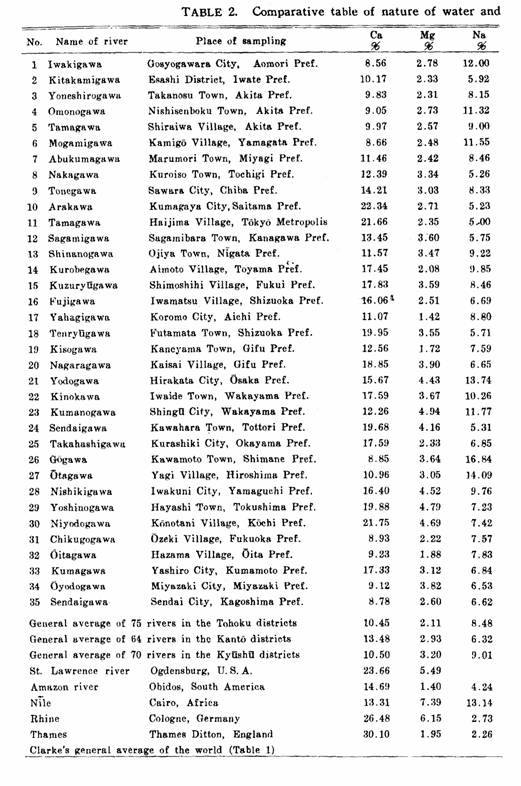
(Right page of Table 2)

As evident in Table 2, the ratio of sulfate to carbonate is
very small in general in the rivers of foreign countries listed,
namely, it is 0.20 in the St. Lawrence River at Ogdensburg, U. S.
A., 0.09 in the Amazon River, 0.11 in the Nile, and 0.28 in the
Rhine and the Thames. In Japan, on the contrary, the ratio is
7.69 in the Yoneshirogawa (at Takanosu Town, Akita Pref.); 5.53
in the Tamagawa (at Shiraiwa Village, Akita Pref.); 4.45 in the
Nakagawa (at Kuroiso Town, Tochigi Prof.) ; 3.49 in the
Kitakamigawa (at Kitakami City, Iwate, Pref.); 2.29 in the
Mogamigawa (at Kamigo Village, Yamagata Pref.) ; 1.96 in the
Abukumagawa (at Marumori Town, Miyagi Pref.) and 1.90 in the
Omonogawa (at Nishisemboku Town, Akita Pref.). The average of the
ratios of 75 rivers in Tohoku district (north-eastern part of the
mainland of Japan) is as high as 1.68, in Kanto district (Tokyo
and its neighborhood) 0.99 and in Kyushu district 0.66. In the
Tonegawa, the biggest river in Japan, it is 0.99 at Sawara City
(lower stream) and in the Shinanogawa it is 0.83 at Ojiya Town
(middle stream). These big rivers are also considered to be
sulfate-surplus. However, we can find out some rivers with low
sulfate content in the regions west of (Tokyo For example, in the
Tamagawa the ratio is 0.36 at Haijima Village near (Tokyo, in the
Kuzuryugawa 0.19 (at Shimoshihi Village, Fukui Pref.), in the
Kisogawa 0.17 (at Kaneyama Town, Gifu Pref.), in the
Takahashigawa 0.26 (at Kurashiki City, Okayama Pref.), in the
Otagawa 0.16 (at Yagi Village near Hiroshima City), in the
Niyodogawa 0.17 (at Konotani Village, Kochi Pref.). In these
rivers, running down Chichibu Palaeozoic stratum which is
composed of sedimentary rock, the ratios are low and comparable
with those in the foreign rivers.
Generally speaking, Japan has many rivers which contain
remarkably large quantity of sulfuric radical as compared with
carbonic one, the alkaline substance. This is apparently due to
the volcanic sulfur-rich nature of the ground in our country.
Sulfur contained in sulfur-springs, sulfide ores and in the soil
is oxidized to sulfuric acid, which causes the sulfate-rich but
carbonate-poor character of the river water.
RELATIONSHIP BETWEEN RIVER WATER OF ABNORMAL- TYPE AND
DEATH-RATE FROM APOPLEXY
As stated above, Japan, especially her north-eastern part of
the mainland, has some "inorganic acid rivers" which contain
sulfuric acid so much as to give apparent injuries to plants and
animals, besides many abnormal- type rivers containing more
sulfate than carbonate, though the reaction is not acid.
Comparing the geographical distribution of rivers of abnormal-
type in Japan with that of death-rate from apoplexy, the writer
is aware of the fact that there exists a close relationship
between the both cases.
The death-rate from apoplexy in 1950 published by Analysis
Section, Statistic Department, Welfare Minister's Office, is
shown in Fig. 1.
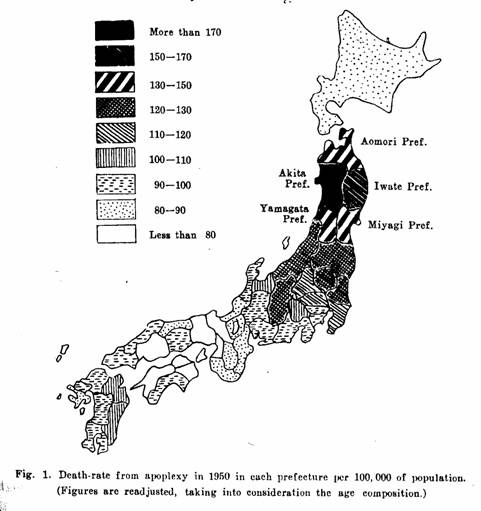
Akita Prefecture occupies the top rank, and next comes Iwate
Prefecture. Aomori, Miyagi, Yamagata, Fukushima, Nigata, Tochigi,
Ibaragi and Nagano Prefectures are also very high, while in
districts west of Tokyo, it is low in general.
As shown in Fig. 2 and Table 3, Akita Prefecture ranks atop
with respect to the ratio of sulfate to carbonate, and next come
Iwate, Aomori, Miyagi and Yamagata Prefectures. On the other
hand, the ratios are generally low in the Prefectures of western
Japan. This suggests us that a high correlation exists between
the death-rate indices from apoplexy and the ratio of sulfate to
carbonate in river water.
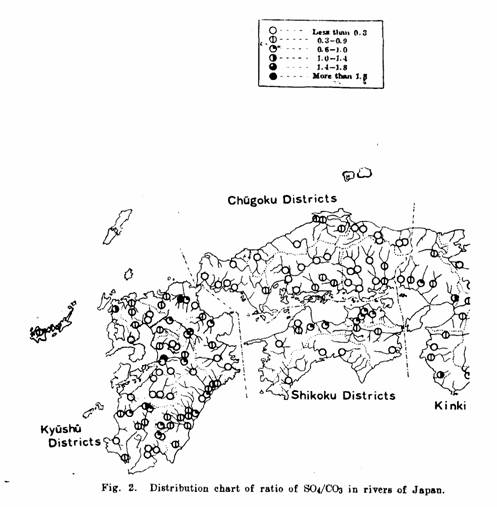
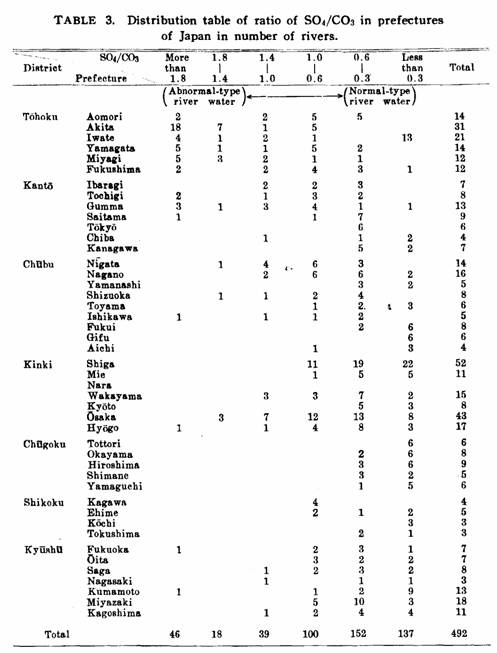
A similar situation is also observable within a Prefecture. In
Iwate Prefecture, for example, we can find a striking contrast
regarding death-rate as such that people who live in the
Kitakamigawa basin show high death-rate from apoplexy while in
the eastern Pacific coastal region the rate is very low. In this
connection, it is noted from Fig. 2 that a number of rivers of
abnormal-type run through the Kitakamigawa basin, whereas the
rivers in the eastern coastal region are so low in sulfate
content as to be regarded as the normal-type ones.
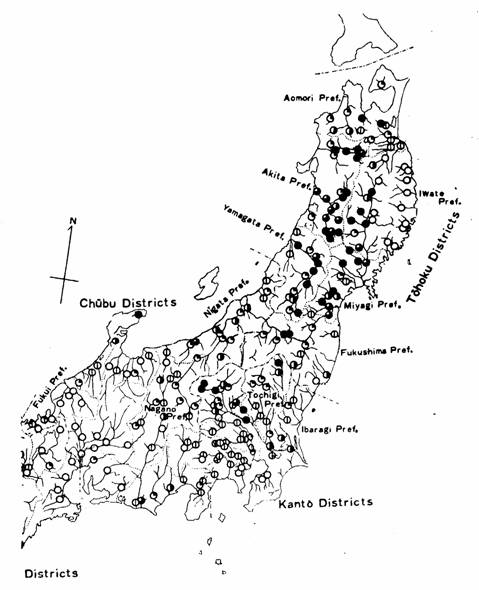
The writer, in his analytical study of the river water of
Thailand, found that the rivers there are carbonate-rich and of
normal type. The ratios are 0.14 in the Mekong and 0.06 in the
Menam Chao Phraya. In this country, cases of apoplexy are scarce
in spite of the fact that rice is the staple food of her nation.
In Okinawa and Formosa, the cases of apoplexy are also scarce,
and the geological construction of these islands enables us to
infer that the ratio of sulfate to carbonate of the river waters
is low. On the other hand, Italy, a famous volcanic country like
Japan, is said to be high in the death-rate from apoplexy,
ranking next to Japan in the world.
All of these evidences stated above seem to be in favor of the
hypothesis that a high correlation exists between the death-rate
from apoplexy and abnormal nature of river water due to the
geological construction of the catchment area.
It is apparently premature to conclude from this that higher
contents of sulfuric acid or sulfate in river water as compared
with alkaline substance (calcium carbonate) should cause
apoplexy, since physiological effect of inorganic acid or alkali
has never been clarified as yet.
However, the above-mentioned correlation found out by the
writer may suggest that the excess of inorganic acid induces
apoplexy for some reason, and calcium carbonate prevents the
case. The writer will be much pleased if the above facts will
give a clue to the solution of the problem of geographic
difference in the death-rate from apoplexy.
The writer desires to take this opportunity to thank Dr.
Masayoshi Yamaguchi, Director of Public Hygiene Bureau, Welfare
Ministry and Dr. Sadamu Watanabe, Statistic Investigation
Department, Welfare Minister's Office, who have shown much
interest in this subject and supplied statistical materials. The
writer also expresses his gratitude to Dr. T. Shimizu, President
of our Okayama University for his kind counsel.
REFERENCES
Clarke, F. W., 1924, Data of Geochemistry. 119.
Kobayashi, J., 1951, Chemical investigation on the water of
rivers in Japan. I. On the quality of water in Akita prefecture.
Ber. Ohara Inst. landw. Forsch. 9 : 329.356.
Kobayashi, J., 1954, Chemical investigation on the water of
rivers in Japan. II. On the quality of water in the Kyushu
districts (in Japanese). Nogaku Kenkyu (Rpt. of Ohara Inst.) 42 :
1-18.
Kobayashi, J., 1955, Chemical investigation on the water of
rivers in Japan. III. The nature of water in the Kanto districts.
Ber. Ohara Inst. landw. Biol. 10 158.214.
Kobayashi, J. (Unpublished) Chemical investigation on the
water of rivers in Japan. IV- VII. The nature of water in the
Tohoku, Chubu, Kinki, Chugoku and Shikoku districts.
Watanabe, S., 1953, Japan an apoplexy country (in Japanese).
Weekly Asahi, April 5, 1953 issue : 44-45.
This page was first uploaded to The Magnesium Web Site on
September 11, 2002
http://www.mgwater.com/







